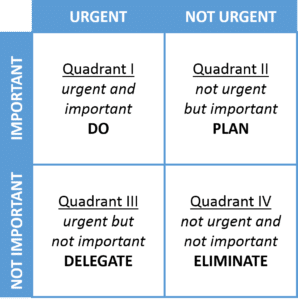How CEOs Can Improve Productivity (Without Burning Out)
June 4, 2019 | Grow Your Business | 1 Comment

Accomplishing more in your company often seems like a tall (but necessary) order. While most of us have some room to improve productivity, it’s a tough balance. Chances are you’re already burning the candle at both ends. Demanding more from your workforce can become demotivating and result in the opposite of the desired effect.
So what’s a CEO to do? How can you improve productivity and maximize your output without burning yourself, or your employees out?
We’d All Like More Hours in the Day
Most entrepreneurs already have much more on their plate than they can reasonably handle. Yet, they’re still seeking ways to accomplish more as they run their business. Competition is fierce and when investors, your workforce, and others rely on you, it means pushing yourself into overdrive.
Like many professionals, you may assume the prospect of accomplishing EVEN more means:
- – More hours
- – More work
- – Less energy
- – Less family
- – Less fun
But the prospect of pushing yourself beyond your limits can have negative results including a higher likelihood of burnout. Even though you started your business with joy in your heart, the constant push may cause it to wane. You began the company because you wanted to be able to do the things that you really love to do, now you are responsible for all of it. As your responsibilities snowballed, you recognize significant priorities and so much more to do than you ever expected. The reality of not being able to do it all sunk in. Not to mention, as you assess your team, the realization hits that you have to get the wrong people off the bus.
Yet, even with all these issues and challenges, you are pushing forward to grow your business. You just wish there were more hours in the day or you could prioritize better. How can a CEO increase productivity when you don’t know what to tackle first?
I’ve been there. When you’re facing so many competing priorities, it’s tough to know how to get it all accomplished. I’ve struggled with priorities just like you. Truth be told, I still struggle (it’s human nature). When I was running my business, I often chose the easiest task to tick off the list or attacked the one I was most confident would be successful. While this seems like a good plan at first, in the long run, it’s not the best idea. Accomplishing the “easy job” leaves us spinning our wheels (and overwhelmed by the boulders we still have yet to push up the hill).
Looking at the horizon, you see so many tasks you need to accomplish, so you seek out efficiency and effectiveness in various ways; from improving time management strategies to implementing more effective delegation to attempting a Covey-type “Big Rocks” approach to addressing your priorities. Nevertheless, there are still tasks on the horizon. How do you improve productivity and how do you make decisions on your plan of approach?
Divide Your To-Do List into Four Quadrants
As a good leader, you should have already listened to input from your team on what they see as priorities—AND added those important items to your list. Now you’re faced with even more priorities. How do you accomplish it all?
But really, what is a priority in the first place? Similar to sales theories, which state there are really only three possible objections to any sales pitch, depending on the stage of your business, priorities fall into 4 buckets. These four areas need to be considered holistically for all stakeholders.
Four Areas of Priorities to Improve Productivity:
-
- Quadrant 1: Projects and issues that are both important and urgent. Address these issues immediately—think of situations like a cash flow crisis
-
- Quadrant 2: Projects that are important, but not urgent. The focus here should be on achieving long-term goals. These tasks would include items like rebranding or selecting and implementing a new system. Often less important but more urgent goals (Quadrant 3) supersede business goals in this quadrant.
-
- Quadrant 3: Projects that are urgent and not important. This area could include timely “favors” for peers, marketing, or networking opportunities. Pinpointing the items that fall into this quadrant is challenging because urgent often feels important (and if it’s unimportant, it organically falls by the wayside). Targeting this area calls for some ruthless weeding of your priorities to eliminate projects that are urgent but truly unimportant to your long-term success. As the Old English proverbs states, “Poor planning on your part does not constitute an emergency on my part.”
-
- Quadrant 4: Unimportant and not urgent tasks that add little or no value to the long-term success of your business. This category would include time wasters (that can mask as productive) like networking by socializing on Facebook or checking your fantasy football standings. Eliminate these time wasters from your to-do list. Often cutting these from your day is simple, but requires self-control. If you’re like me, Quadrant 4 is where I spend my time “practicing avoidance techniques.” This, of course, means I’m not addressing something I should be doing in Quadrant 1 or 2.
It’s not to say you should only spend your time on Quadrant 1 and 2 at all times. There are days when you need a brain break, or when doing a favor for a peer can ultimately lead to positive results, or when team building and socializing doesn’t help the work environment.
However, if you’re wondering how a CEO can increase productivity, the simple answer is prioritizing (especially if you’re overwhelmed by your current to-do list). We can’t do it all. If you want to know where your time goes, look at your task manager on your phone, or monitor the time you spend responding back and forth on email, social media, and on Slack. Something’s got to give on your schedule, so you can find more time to spend on the activities that bring your joy (in real life).
Assessing the Scope of Your Important Priorities
Once you’ve focused on the priorities and tasks that fall into Quadrant 1 & 2, it’s time to decide on a plan of attack. This essentially means, prioritizing your priorities.
Review the list. To assess the scope, we need to add another characteristic: size. The size of the task has two main variables:
Breadth – How wide is the impact within the Company? Does this priority only affect one department (such as implementing a change in a procedure) or does the entire organization need to participate in this initiative (such as selecting and implementing an ERP system)?
Magnitude – How much is the resource commitment needed for the project? Can a couple of people manage it over a short period of time or does it need months of work by many people?
No matter the size of the priority, the plan of attack starts with:
-
- – Clearly defining the problem that needs solving or the objective you are seeking. The problem may be anything from eliminating machine downtime to improving cash management, to higher people utilization. Be as specific as possible when you articulate and define the issue.
-
- – Determining if you have the right team members, time, and capability to solve the defined issue, or if you will need to pull in outside resources.
-
- – Assisting in breaking the analysis and solution into clearly defined steps. What are the milestones within the set timeline to get the project done or accomplish the objective?
Addressing Problems with a Team Approach
For priorities with a wide breadth and of significant magnitude, you will often need outside help. An objective source can help you to identify and vet possible solutions and then implement the selected approach. If you have a strong team and resources available (such as time and materials), you may be able to manage to address the issue internally. Frequently, CEOs use outside consulting firms to aid in the identification and implementation of large, high priority projects, such as an ERP implementation. Calling in expert guidance will help you save, time, money, and the hassle of going the wrong direction. Remember, you don’t know what you don’t know; sometimes it’s wise to rely on a party with experience.
The narrower breadth and smaller magnitude projects may cascade throughout the organization. It’s important that the team feels involved in the prioritization process. Everyone should keep in mind that their highest priority may not make it to the company’s highest priorities list. Still, allowing team members to identify and complete projects to address their own highest priorities engages the team and encourages broader contributions. Ultimately, this personal buy-in will increase productivity and engagement throughout the organization.
When I ran my company, I gave team members the authority to identify and solve issues that were important to them. For example, getting an outside vendor to write documentation to make tax reporting easier may not bubble up as a corporate priority. But having this documentation was important to the team member who would otherwise spend extra time generating the report. The amount of money requested to cover the documentation easily fit within the budget and was well worth the increase in both productivity and morale.
Properly prioritizing, setting clear objectives, and creating the plan for the projects assures positive outcomes from the solutions whether internal or external. Allowing team members to develop personal priorities along with participating in company solutions engages team members in improvements as well as keeps good ideas percolating to the top.
Remember, as CEO, the buck may stop with you, but it’s not your sole responsibility to increase the productivity of the entire company. By clearly defining priorities and creating a plan of attack with team buy-in, you will see positive engagement and support. Ultimately, you set the tone, but burning yourself out won’t make your company more successful in the long run.
Instead, rely on effective delegation and improved prioritization of your tasks. With strong time management, you’ll find time to run your business and still enjoy the journey.
Featured image and post images licensed for use via Burst.







One Comment
Robert Krieghoff
the four quadrants to improve productivity. Haven’t seen that one in a while. Great refresher!